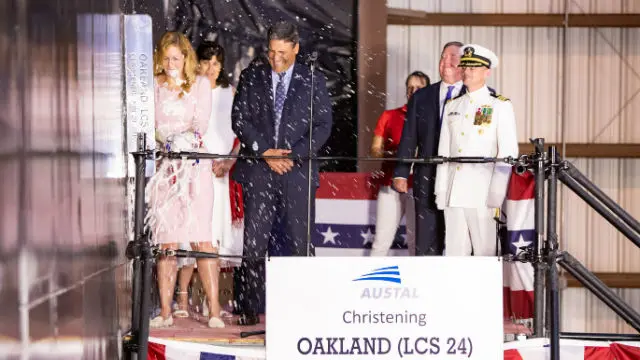
USS Oakland (LCS 24) Christened
Kate Brandt christens the future USS Oakland on Saturday. Courtesy Austel USA
(Article Appears Courtesy of NAVSEA)
The future USS Oakland (LCS 24) launched July 21 at Austal USA’s ship manufacturing facility in Mobile, Alabama. This event marked the first time the ship floated in the water as it is prepared for delivery next year.
The future USS Oakland is the 12th of 19 Independence-variant littoral combat ships (LCSs) that will join the fleet. Ship sponsor Kate Brandt, Google’s sustainability officer, christened the vessel in Mobile on June 29.
She previously welded her initials onto a steel plate included in Oakland’s hull during a keel-laying ceremony on July 20, 2018. Brandt is a recipient of the Distinguished Public Service Award, the highest award the U.S. Navy can give to a civilian.
Four additional LCSs are under various stages of construction at Austal’s Alabama shipyard. The future USS Kansas City (LCS 22) is preparing for sea trials. The future USS Mobile (LCS 26), Savannah (LCS 28) and Canberra (LCS 30) are under construction, and Austal has four more LCSs under contract.
The future USS Oakland honors the long-standing history its namesake city has with the Navy. It will be the third naval ship to bear the city’s name.
The first, commissioned in 1918, was largely used to transport cargo. The second USS Oakland was commissioned in 1942 during the height of World War II. While in service for just seven years, it was key in many antiaircraft missions in places such as Pearl Harbor, Marshall Islands, Pagan, Guam, Iwo Jima, Rota, Peleliu and Okinawa. After the war, Oakland performed two duty patrols off the coast of China before being decommissioned.
The littoral combat ship is a fast, agile, mission-focused platform designed to operate in near-shore environments, while capable of open-ocean tasking and winning against 21st-century coastal threats such as submarines, mines, and swarming small craft. They are capable of supporting forward presence, maritime security, sea control and deterrence.
The Freedom-variant and the Independence-variant are designed and built by two industry teams. The Freedom-variant team is led by Lockheed Martin and Fincantieri Marinette Marine, Marinette, Wisconsin, and the Independence-variant team is led by Austal USA.
Tags:
